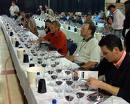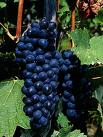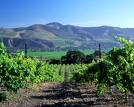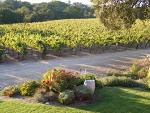This past weekend marked the 17th edition of Hospice du Rhône,  a celebration of Rhône varieties worldwide that places American Rhône wines and its producers in an international context. It’s a time for celebration, silliness, a bit of indulgence, many ugly shirts, much bad bowling, and a lot of very serious tasting. It’s our annual snapshot of the Rhône movement in all its forms.
a celebration of Rhône varieties worldwide that places American Rhône wines and its producers in an international context. It’s a time for celebration, silliness, a bit of indulgence, many ugly shirts, much bad bowling, and a lot of very serious tasting. It’s our annual snapshot of the Rhône movement in all its forms.
The celebration was a perhaps a bit muted this year, owing to the economic times; attendance was down, as was the number of international participants, who invariably provide some extra excitement and star power to the proceedings (guest speakers have included Philippe Guigal, Alvaro Palacios, Stephen and Prue Henschke, Roman Bratasiuk, Alain Dugas, Marc Perrin, Yves Cuilleron, and Francois Villard, to name but a few). This year’s one international speaker was not a winemaker — he was the Austrian glass wizard George Riedel, who gave a spirited demonstration of the virtues of his superb crystal glassware by obliging his audience to taste good wine in large glasses, small glasses, other, lesser glasses, and even in (horrors!) plastic cups. Doubtless none who attended the seminar will ever make THAT mistake again.
Lately at Hospice du Rhône, Syrah has been the pre-eminent player; it tends to dominate the acreage, the bottlings, the  blends, the tastings, and most of the conversation. At least some of that conversation this year involved how you sell it in such a moribund economy, in what amounts to the second blow to the category in recent years — the first being Sideways and the Pinot Noir explosion, which certainly stole momentum for Syrah and other Rhône varieties when it whooshed across the landscape five short years ago.
blends, the tastings, and most of the conversation. At least some of that conversation this year involved how you sell it in such a moribund economy, in what amounts to the second blow to the category in recent years — the first being Sideways and the Pinot Noir explosion, which certainly stole momentum for Syrah and other Rhône varieties when it whooshed across the landscape five short years ago.
Syrah’s been in commercial production in California since 1974, and its acreage has skyrocketed in that time. Since Hospice was founded, Syrah acres under vine have increased tenfold, to 18,875 acres. So we finally have enough to play with.
And that, you could say, was driving one of the other conversations about Syrah at this year’s Hospice. Syrah is eminently adaptable to different climates, different growing techniques, different trellising systems, oak regimes, etc., imparting wildly divergent variations on style.
Lately there’s been a lot of discussion in the press about Syrah and climate, especially over recent plantings of Syrah in regions that were, not too long ago, thought to be too cold for Pinot Noir.
Not everyone is happy with the nomenclature; recently Jon Bonné dismissed the term “cold climate” altogether in the San Francisco Chronicle, damning it as nothing more than a buzzword, useful to marketers but perhaps, ultimately, misleading for the fact that it’s just one factor among many, that must be considered when evaluating the finished wine, including yield, aspect, clone, diurnal shifts, and so forth.
Perhaps a better way of looking at the problem comes from Ojai’s Adam Tolmach, who in a recent article by Corie Brown in the Los Angeles Times, praised cool weather sites for their marginality with respect to Syrah, saying ‘when grapes are grown on the edge of where they will ripen, you are in the right place.’
But of course there are other edges — edges of extract, of concentration, of ripeness, color, saturation, and even, I suppose, tolerance — Syrah seems to be able to flirt with all stylistic tightropes.
Advocates of ‘cool climate’ Syrahs love these wines because they possess such lifted aromatic complexity and textural finesse. They compare these wines with the Syrahs of the Northern Rhône, e.g., Côte Rôtie and Hermitage.
However there are many vocal supporters of Syrahs of the ‘not-so-cool climate’ version, grown in warmer sites, and are often compared with wines of the southern Rhône, or with Australian Shiraz. These wines may lack in aromatic complexity, but they certainly don’t lack for power, concentration or out-and-out guts.
Thus Hospice du Rhône 2009 laid out a playing ground that featured these two extremes and an even more interesting middle ground.
* * *
On the one extreme you have the cool climate Syrahs of the  Santa Rita Hills and the Santa Maria Valley, the former characterized by the wines of Melville, Ampelos, Foley and Cold Heaven, the latter characterized by the Bien Nacido bottlings of Qupe, Jaffurs, Kynsi and Bonny Doon. This is the sort of Syrah fruit that routinely hangs on the vine well into November, and even sometimes later.
Santa Rita Hills and the Santa Maria Valley, the former characterized by the wines of Melville, Ampelos, Foley and Cold Heaven, the latter characterized by the Bien Nacido bottlings of Qupe, Jaffurs, Kynsi and Bonny Doon. This is the sort of Syrah fruit that routinely hangs on the vine well into November, and even sometimes later.
The Santa Rita Hills is one of the coolest AVAs in California. The Syrahs from there are pristine, cool in character; they rarely lack for fruit or concentration, but you wouldn’t call them powerful, necessarily. Instead, they lead with more savory scents of violets and white pepper, the fruit black but often very firm, and bearing a finesse that for the last several years has been the exception and not the rule in California.
Bien Nacido Syrah often bears a bit more richness and a more savory, smoky character. To me it often has a subtle marine, sea wrack herbal scent as well. Qupe’s Hillside Estate, to my mind, remains the pinnacle of Syrah expression from that vineyard, though Bob Lindquist’s new reserve Block XI, derived from a single block, may surpass its predecessor.
(Cool climate character in Syrah is not limited to the Central Coast, of course: the wines from Peay Vineyard, in the outer ridges of the Sonoma Coast, are wonders of nerve and minerality for the variety; and seek Pax Mahle’s new brand situated in the Petaluma Gap, called Wind Gap, for which I tasted a savory, olive-scented Syrah that reminded us all of St. Joseph.)
* * *
At the other extreme is the Paso Robles AVA. Paso is home to  the first modern planting of Syrah in 1975, when Gary Eberle, fresh out of enology school, planted a pair of 20-acre parcels at Estrella River Winery in Paso from a small patch of vines he had unearthed in an experimental vineyard at the University of California in Davis. The vines, he was told, came from Chapoutier, but they’ve been known ever since as the Estrella Clone. Eberle made Syrah and propagated much more; the Estrella River clone made its way across the Central Coast, up to Napa, across state lines to Washington State. It is far and away the most widely planted Syrah clone in the Central Coast.
the first modern planting of Syrah in 1975, when Gary Eberle, fresh out of enology school, planted a pair of 20-acre parcels at Estrella River Winery in Paso from a small patch of vines he had unearthed in an experimental vineyard at the University of California in Davis. The vines, he was told, came from Chapoutier, but they’ve been known ever since as the Estrella Clone. Eberle made Syrah and propagated much more; the Estrella River clone made its way across the Central Coast, up to Napa, across state lines to Washington State. It is far and away the most widely planted Syrah clone in the Central Coast.
Not quite 15 years later, wine importer Robert Haas and his family started a joint venture with his longtime import partner, the Perrin Family from Chateau de Beaucastel in Chateauneuf du Pape. Together they established Tablas Creek in Paso Robles, and set about importing all 17 of the Chateauneuf varieties (which involved waiting out a quarantine, not yet complete for about six varieties).
So it’s inevitable that Paso should become a hotbed of Rhône variety wines. And in the last few years a great many artisanal producers there have achieved rockstar status for their Syrahs, including Justin Smith of Saxum Vineyards, Eric Jensen of Booker Vineyards, Chris Cherry of Villa Creek Winery, and Stephan Asseo of L’Aventure winery. With each of these producers, the calling card is power: raw, unbridled, concentrated, rippling power, dark, mouth-filling fruit, a rich savory spice note that often, this weekend, put me in mind of German chocolate cake, and chewy, gripping, tannic length (and usually a few extra degrees of alcohol). This is the style of Syrah that knocks you back on your heels — if you get up off the floor and lift your glass for more, consider yourself part of the insurgency.
* * *
If there is a middle ground in the Central Coast, I think it may lie  in the Santa Ynez Valley, in Santa Barbara County. This transverse system of valleys (which includes the Santa Rita Hills) is fully exposed to the ocean, so there are daily marine incursions of fog and wind. Where your patch of ground lies in relation to this great cycle of weather will have a lot to do with how that Syrah vineyard will develop, ripen and taste.
in the Santa Ynez Valley, in Santa Barbara County. This transverse system of valleys (which includes the Santa Rita Hills) is fully exposed to the ocean, so there are daily marine incursions of fog and wind. Where your patch of ground lies in relation to this great cycle of weather will have a lot to do with how that Syrah vineyard will develop, ripen and taste.
The valley is cool in spots, not so cool in others. It’s said that for each mile you travel east, you pick up one degree of temperature. Logic dictates that someplace along this continuum you’ll find a kind of harmony, an equipoise, the ideal balance of warm climate power with cool climate finesse. For me, right now, that’s Ballard Canyon.
Ballard Canyon lies between Buellton and Santa Ynez, east of the Santa Rita Hills by about ten miles — and it just might be the perfect middle ground. Just try the wines from these four vineyards, which represent Ballard Canyon at its most promising: Jonata, a new project from the folks who bring you Screaming Eagle; Purisima, owned by winemaker Steve Beckman and his father; Stolpman, owned by the Stolpman family and managed by the estimable Sashi Moorman; and not least, Larner. The latter three sell fruit to dozens of wineries; if you find these names on a Rhône bottling, snatch it up.
Ballard Canyon’s soils remind one of the ocean — plenty of sand, but with good deposits of limestone and chalk as well, a rarity in California. Purisima, for example, has a large deposit of limestone which provides a mineral current to its dark Syrah and Grenache fruit. At Larner the soils are sandier, but the result is an assertive charge of dark purple fruit character that might be the most intensely pure in the valley.
Stolpman Vineyard, meanwhile, is 170 acres, with a wide array of trellising, planting densities, and aspects, resulting in some very  different wines. At a seminar this year, Sashi Moorman offered samples of Syrahs blocks with vine densities as high as 6000 plants per acre (and trained vertically in the manner of Côte Rôtie). Each wine tasted vastly different, but all had a fine smoky tension; fully ripe, fully charged, rippling more with energy than power.
different wines. At a seminar this year, Sashi Moorman offered samples of Syrahs blocks with vine densities as high as 6000 plants per acre (and trained vertically in the manner of Côte Rôtie). Each wine tasted vastly different, but all had a fine smoky tension; fully ripe, fully charged, rippling more with energy than power.
Taken together, these three iterations served as a good reminder of how important the Central Coast has become in defining California Syrah. The region has contributed much to the history of the grape in California, and that history is far from complete.
